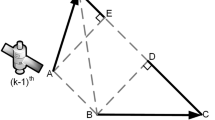Abstract
The conventional hybrid search algorithm for direct sequence spread spectrum (DSSS) signal acquisition terminates once a decision variable exceeds the detection threshold. Therefore, a spurious “hit” declared before the search reaches the cell where the target signal is located avoids any possibility of a correct detection. This behavior increases the probability of false detection, especially in abnormal scenarios, such as when in the presence of interfering signals. To improve the probability of correct detection under a constant false-alarm rate criterion, this paper proposes an advanced hybrid acquisition scheme, whose search area is extended to the whole Doppler frequency and code phase delay uncertainty region. To reduce the mean acquisition time (MAT) increment resulting from this increased search area, both parameters of a Tong detector and the detection threshold are adaptively customized, according to a signal-to-noise ratio estimate obtained during the search operation. In addition, analytic expressions for the detection probability and false-alarm probability are derived. The most prominent advantage of the proposed method is that it can reduce the false detection probability noticeably, with little increase in resource utilization, and an acceptable MAT. The validity of this algorithm is verified, both theoretically and through simulation. The proposed algorithm is particularly suitable for DSSS signal acquisition when in the presence of either multiple access interference or continuous wave interference.














Similar content being viewed by others
References
Tabatabaei, A., & Mosavi, M. R. (2015). A fast GLONASS FDMA acquisition algorithm using multi-satellite search strategy. Wireless Personal Communications, 84(4), 2665–2678.
Chugg, K. M., & Zhu, M. (2005). A new approach to rapid PN code acquisition using iterative message passing techniques. IEEE Journal on Selected Areas in Communications, 23(5), 884–897.
Hacini, L., Farrouki, A., & Hammoudi, Z. (2012). Adaptive hybrid acquisition of PN sequences based on automatic multipath cancellation in frequency-selective Rayleigh fading channels. Wireless Personal Communications, 63(1), 147–166.
Borio, D., Camoriano, L., & Presti, L. L. (2008). Impact of GPS acquisition strategy on decision probabilities. IEEE Transactions on Aerospace and Electronic Systems, 44(3), 996–1011.
Lohan, E. S., Lakhzouri, A., & Renfors, M. (2004). Selection of the multiple-dwell hybrid-search strategy for the acquisition of Galileo signals in fading channels. In Proceedings of the 15th IEEE international symposium on personal, indoor and mobile radio communications (pp. 2352–2356).
Zhuang, W. (1996). Noncoherent hybrid parallel PN code acquisition for CDMA mobile communications. IEEE Transactions on Vehicular Technology, 45(4), 643–656.
Lee, S., & Kim, J. (2002). Effects of multiple threshold values in double dwell DS-SS code acquisition systems. IEEE Communications Letters, 6(1), 1–3.
Qaisar, S. U., & Dempster, A. G. (2007). An analysis of L1-C/A cross correlation and acquisition effort in weak signal environments. In Proceedings of the international global navigation satellite systems society, IGNSS symposium (paper 107).
Hsieh, Y. T., & Wu, W. R. (2011). Adaptive parallel interference cancellation for CDMA systems—A weight selection and filtering scheme. Signal Processing, 91(1), 1–14.
Choi, J. W., & Cho, N. I. (2002). Suppression of narrow-band interference in DS-spread spectrum systems using adaptive IIR notch filter. Signal Processing, 82(12), 2003–2013.
Arribas, J., Fernandez-Prades, C., & Closas, P. (2013). Antenna array based GNSS signal acquisition for interference mitigation. IEEE Transactions on Aerospace and Electronic Systems, 49(1), 223–243.
O’Mahony, N., Murphy, C. C., & Lachapelle, G. (2011). A dual-threshold up-down counter for GPS acquisition. Signal Processing, 91(5), 1093–1102.
Dempster, A. G. (2008). Use of comb filters in GPS L1 receivers. GPS Solutions, 12(3), 179–185.
Zheng, Y., Xiaowei, C., Mingquan, L., & Zhenming, F. (2007). Performance analysis of sequential detector for GPS receivers. Journal of Tsinghua University (Science and Technology), 47(7), 1166–1169. (in Chinese).
Iinatti, J. H. (2000). On the threshold setting principles in code acquisition of DS-SS signals. IEEE Journal of Selected Areas in Communications, 18(1), 62–72.
Giunta, G., Neri, A., & Carli, M. (2003). Constrained optimization of noncoherent serial acquisition of spread-spectrum code by exploiting the generalized Q-functions. IEEE Transactions on Vehicular Technology, 52(5), 1378–1385.
Deng, Z., Shen, L., Bao, N., Su, B., Lin, J., & Wang, D. (2011). Autocorrelation based detection of DSSS signal for cognitive radio system. In Proceedings of the IEEE international conference on wireless communications and signal processing (WCSP) (pp. 1–5).
Borio, D., Gernot, C., Macchi, F., & Lachapelle, G. (2008). The output SNR and its role in quantifying GNSS signal acquisition performance. In Proceedings of the European navigation conference (pp. 23–25).
Wei, H., & Sun, H. (2010). Using Bayesian game model for intrusion detection in wireless ad hoc networks. International Journal of Communications, Network and System Sciences, 3(7), 602–607.
Garnaev, A., & Trappe, W. (2016). A bandwidth monitoring strategy under uncertainty of the adversary’s activity. IEEE Transactions on Information Forensics and Security, 11(4), 837–849.
Acknowledgments
This work was supported by the National Natural Science Foundation of China (Grant No. 61401026) and the National High Technology Research and Development Program of China (Grant No. 2014AA1070).
Author information
Authors and Affiliations
Corresponding author
Rights and permissions
About this article
Cite this article
Shen, Y., Wang, Y., Yu, X. et al. Whole-Region Hybrid Search Algorithm for DSSS Signal Acquisition. Wireless Pers Commun 95, 1265–1284 (2017). https://doi.org/10.1007/s11277-016-3828-1
Published:
Issue Date:
DOI: https://doi.org/10.1007/s11277-016-3828-1




